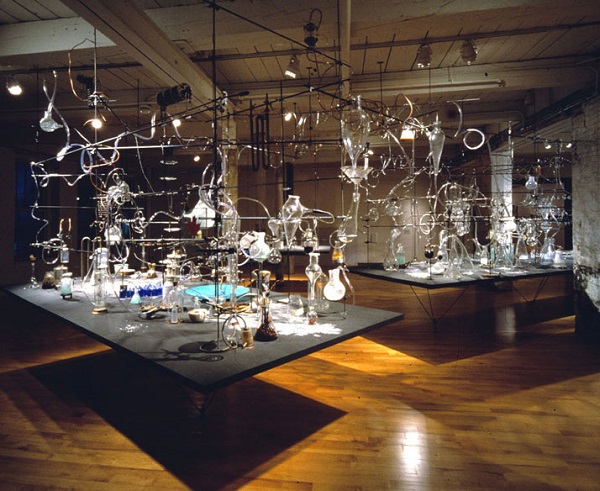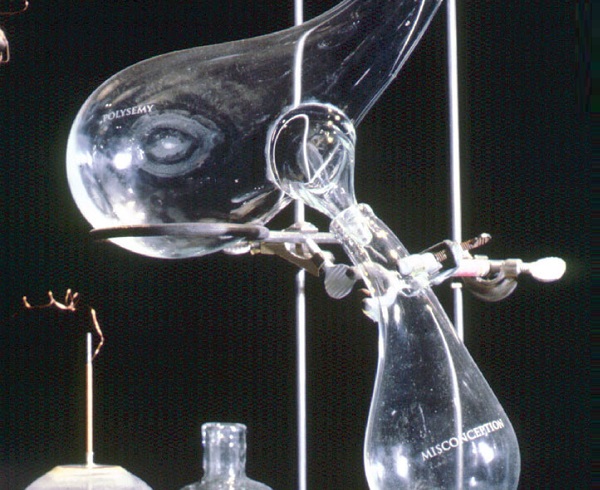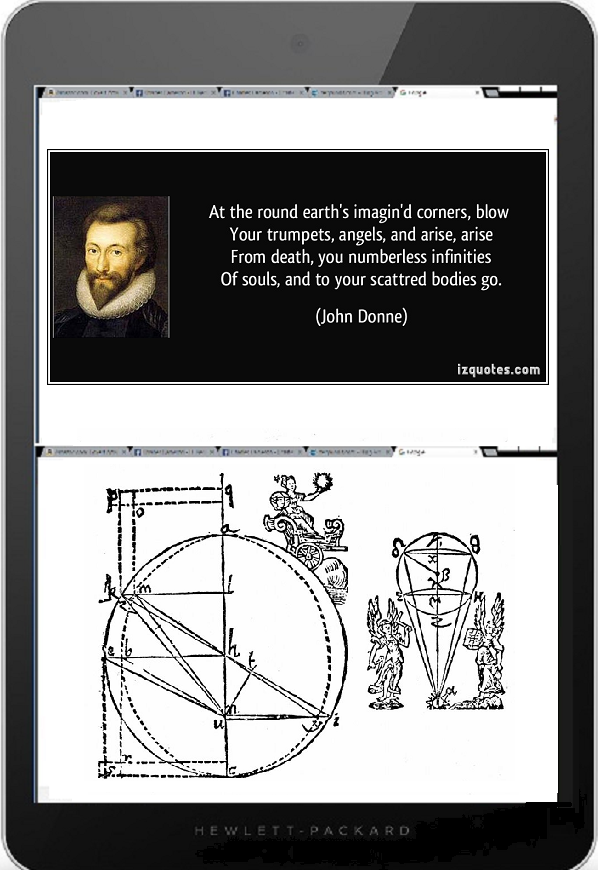[ by Charles Cameron — a poem that’s far too philosophical to work as poetry, Laramée’s Apparatus, and Alyce Santoro’s philosoprops ]
.
The logic of poetry is, más o menos, dream logic, and so I’ve been pondering the logic of dreams and recently wrote this not terribly poetic poem:
The egg at the conjuror’s table
There is a topology of dreams.
Out beyond Riemann and names I have yet to learn,
there are configurations of space:
past Boole, dreams have their logics.
*
Take an egg.
With a tap of the wand, crack it open,
let it fall apart so precisely
the two half-shells could again fit together,
ovoid, seamlessly,
almost an egg.
Catch white and yolk in a glass.
Toss up and catch the half shell in your left hand
holding the right steady,
bring them together, there’s a fit,
a logic to it, a topology, one
to one, across many thousands of facets
of fragile, broken shell.
Break another egg so preciely
the left half of ts shell would match exactly
the right half of the first,
bring them together,
the fit is exact by definition,
brown shell with speckled,
but there is loss of logic, the thing is surreal,
an egg not an egg at all.
Holding the half-shell in your right hand
face upwards, pour into it
yolk and white of the same egg,
the heart of the egg filling its own shell,
the fit ovoid, but better:
the original yolk united with its familiar shell.
Cover shell and all with a handkerchief,
red, green, blue,
whisk it away, and the egg vanishes —
or appears, whole.
**
There are logics, topologies,
affinities beyond the exact match
of shell and shell,
and so between times, places,
people in dreams –
the half hovel, half cathedral
with its walkways among lily ponds, the koi,
dusk in one century dawn in another,
her youth your old age your youth again, time
cracked open so precisely,
its yolk, meaning,
its moments an exact match across centuries,
its half-shell a perch for Venus,
its wholeness Fabergé,
its yolk, tempera mixed by Giotto,
meaning, tempera, Assisi,
gesso, the chalk cliffs of Dover, the sea..
There is a harmony of the whole,
of the broken unbroken,
named yet unnameable, unspeakable,
there is a logic.
there is a topology of the sundries of dreams,
a mathematics to this matching
of thou with i,
of words, asleep, awake, of dusk to dawn, with all.
Recognising that it belongs in a category she might call philosopoetry, I sent it to my friend, the artist Alyce Santoro, author of the remarkable Philosoprops: A Unified Field Guide>
**
I’m a lucky fellow.
Today, via 3 Quarks Daily, I ran across this quote from Walter Bejamin:
I had suffered very much from the din in my room. Last night the dream retained this. I found myself in front of a map and, at the same time, in the landscape which was depicted on it. The landscape was incredibly gloomy and bleak, and it wasn’t possible to say whether its desolation was merely a craggy wasteland or empty grey ground populated only by capital letters. These letters drifted curvily on their base, just as if they were following the mountain range; the words formed from these letters were more or less remote from each other. I knew, or came to know, that I was in the labyrinth of the ear canal. The map was at the same time a map of hell.
There’s something darkly Borgesian about that quote, eh? But it certainly illuminates dream topology, and even moreso, the topology of the relationship of dream to waking, itself worth comparing with the relationship of map to territory, word to referent, and indeed moon to finger with which Count Korzybski, Lao Tzu, and the Zen poets are each so notably concerned.
**
Tunneling on through, I find myself contemplating one of Alyce’s inspirations — Eve Andrée Laramée’s Apparatus for the Distillation of Vague Intuitions, shown in Mass MoCA‘s 2000-2001 exhibition Unnatural Science, from 2000 – 2001:

A detail from that work illustrates the etching of certain phrases into the glass — in this case, the words polysemy and misconception:

The display is characterized in this piece from Art & Science Jounral:
Apparatus for the Distillation of Vague Intuitions by American artist Eve Andrée Laramée consists of an array of tall metal stands, clamps, PVC tubings, glass beakers, flasks and vials. Although much of the equipment looks standard from afar, the installation is a dysfunctional and mythological sort of laboratory that highlights the inherent but often unnoticed subjectivity in scientific inquiry. [ .. ]
In this fantastical and visually dazzling Apparatus, many of the glassware are hand-blown with various cloudy or luminous turquoise solutions and copper wires attached to large exotic flowers contributing to the spectacle of a giant chemistry experiment gone amok.
Upon close inspection, a second level of complexity is revealed by the seemingly unscientific words and phrases such as “HANDFULS”, “LEAP IN THE DARK” and “UNNECESSARY EXPLANATORY PRINCIPLES” delicately etched into the glass, exposing a sense of insecurity and imprecision behind the process of science.
**
My Egg at the conjuror’s table is really more a philosoprop, to use Alyce’s coinage, than what many expect a poem to be, and likewise Laramée’s Apparatus more a philosoprop than what many expect an artwork to be.
Philosoprops:
The word philosoprop is a portmanteau of philosophy (love of wisdom) and either prop (theatrical property) or propaganda (influential communication), depending. A philosoprop is a device, implement, or illustration – crafted or discovered ready-made – that can be used for the purpose of demonstrating a concept or sparking a dialog.
Let’s talk..







